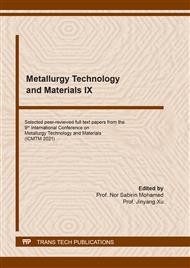[1]
Feng Gao, Xiao Huang. A study of pack aluminizing process for NiCrAlY coatings using response surface methodology. Journal of Materials Engineering and Performance,23(2014),83-91.
DOI: 10.1007/s11665-013-0665-1
Google Scholar
[2]
P. Cavaliere, A. Silvello. Crack initiation and growth behavior of cold-sprayed Ni particles on IN718 alloy. Journal of Materials Engineering and Perfroomance,26(2017),1929-1937.
DOI: 10.1007/s11665-017-2620-z
Google Scholar
[3]
Lina Gao, Fenfen Han. Effect of isothermal aging on microstructure evolution of Ni claddings on Inconel 617. Journal of Materials Engineering and Performance,30(2021),2389-2398.
DOI: 10.1007/s11665-021-05629-z
Google Scholar
[4]
H.T. Yupanqui, Amir Armani. Additive manufacturing of functional Inconel 718 parts from recycled materials. Journal of Materials Engineering and Performance,30(2021),1177-1187.
DOI: 10.1007/s11665-020-05402-8
Google Scholar
[5]
Christopher Kantzos, Joseph Pauza. An investigation of process parameter modifications on additively manufactured Inconel 718 parts. Journal of Materials Engineering and Performance, 28(2019),620-626.
DOI: 10.1007/s11665-018-3612-3
Google Scholar
[6]
M.C. Brennan, J.S. Keist. Defects in metal additive manufacturing processes. Journal of Materials Engineering and Perfroomance,30(2021),4808-4818.
DOI: 10.1007/s11665-021-05919-6
Google Scholar
[7]
G.E. Bean, T.D. Mclouth. Build orientation effects on texture and mechanical properties of selective laser melting Inconel 718.Journal of Materials Engineering and Performance,28(2019), 1942-1949.
DOI: 10.1007/s11665-019-03980-w
Google Scholar
[8]
Qiang Zhang, Pan Ren. Effect of heat treatment on microstructure evolution and mechanical properties of selective laser melted Inconel 718 alloy. Journal of Materials Engineering and Performance,28(2019),5376-5386.
DOI: 10.1007/s11665-019-04309-3
Google Scholar
[9]
J. Durocher, N.L. Richards. Characterization of the micro-welding process for repair of nickel- based superalloys. Journal of Materials Engineering and Performance,16(2007),710-719.
DOI: 10.1007/s11665-007-9112-5
Google Scholar
[10]
Xiaohui Yin, Guoqiang He. Comparison study of low-heat-input wire arc-fabricated nickel- based alloy by cold metal transfer and plasma arc. Journal of Materials Engineering and Performance, 29(2020),4222-4232.
DOI: 10.1007/s11665-020-04942-3
Google Scholar
[11]
Qianfeng Liu, Changjun Chen. Effect of different heat treatments on the microstructural evolution and mechanical properties of Ni-Cr-Si alloy fabricated by laser additive manufacturing. Journal of Materials Engineering and Performance,28(2019),4543-4555.
DOI: 10.1007/s11665-019-04239-0
Google Scholar
[12]
M. Sathishkumar, M. Manikandan. Development of pulsed current arc welding to preclude carbide precipitates in Hastelloy X weldment using ERNiCr-3.Journal of Materials Engineering and Performance,29(2020),5395-5408.
DOI: 10.1007/s11665-020-05010-6
Google Scholar
[13]
K.D. Ramkumar, A.J. Bhalodi. Effect of Mo-rich fillers in pulsed current gas tungsten arc welding of Inconel 718 for improved strength and hot corrosion resistance. Journal of Materials Engineering and Performance,26(2017),5620-5640.
DOI: 10.1007/s11665-017-3009-8
Google Scholar
[14]
Morteza Shamanian, A. Rahimi. Characterization of microstructure and texture across N155 superalloy weldment joint with austenitic filler metal. Journal of Materials Engineering and Performance,29(2020),1964-1973.
DOI: 10.1007/s11665-020-04707-y
Google Scholar
[15]
Zhengfei Hu, Defeng Mo. Different behavior in electron beam welding of 18NiCo-free maraging steels. Journal of Materials Engineering and Performance,17(2008),767-771.
DOI: 10.1007/s11665-007-9190-4
Google Scholar
[16]
Sumit K. Sharma, K. Biswas. Effect of heat input on mechanical and electrochemical properties of electron-beam-welded Inconel 718.Jounral of Materials Engineering and Performance,29(2020), 1706-1714.
DOI: 10.1007/s11665-020-04660-w
Google Scholar
[17]
R.A. Buckson, O.A. Ojo. Analysis of the influence of laser welding on fatigue crack growth behavior in a newly developed nickel-based superalloy. Journal of Materials Engineering and Performance,24(2015),353-361.
DOI: 10.1007/s11665-014-1272-5
Google Scholar
[18]
Renato Baldan, P.R. Silva. Aging of a new niobium-modified Mar-M247 nickel-based superalloy. Journal of Materials Engineering and Performance,22(2013),2337-2342.
DOI: 10.1007/s11665-013-0531-1
Google Scholar
[19]
A. Szczotok, B. Chmiela. Effect of heat treatment on chemical segregation in CMSX-4 nickel- based superalloy. Journal of Materials Engineering and Performance,23(2014),2739-2747.
DOI: 10.1007/s11665-013-0843-1
Google Scholar
[20]
Lu Chai, Jinbao Hou. Effect of base metal misorientation on single-crystal superalloy transient liquid phase bonded joints. Journal of Materials Engineering and Performance,27(2018),5718-5724.
DOI: 10.1007/s11665-018-3641-y
Google Scholar
[21]
Lu Chai, Jihua Huang. Effect of holding time on microstructure and properties of transient liquid-phase-bonded joints of a single crystal alloy. Journal of Materials Engineering and Performance,24(2015),2287-2293.
DOI: 10.1007/s11665-015-1504-3
Google Scholar
[22]
C.Y. Su, W.J. Chang. Effect of mechanical properties using different filler metals on wide- clearance activated-diffusion-brazed Ni-based superalloy. Journal of Materials Engineering and Performance, 9(2000),663-668.
DOI: 10.1361/105994900770345539
Google Scholar
[23]
K. Harris, G.L. Erickson. Development of two rhenium-containing superalloys for single-crystal blade and directionally solidified vane applications in advanced turbine engines. Journal of Materials Engineering and Performance,2(1993),481-487.
DOI: 10.1007/bf02661730
Google Scholar
[24]
Zhiguo Gao. Numerical analysis of stray grain formation during laser welding nickel-based single-crystal superalloy part I: columnar/equiaxed morphology transition. Journal of Physics: Conference Series,1888(2021),012004.
DOI: 10.1088/1742-6596/1888/1/012004
Google Scholar
[25]
Zhiguo Gao. Numerical analysis of stray grain formation during laser welding nickel-based single-crystal superalloy part II: multicomponent dendrite growth. Materials Science Forum,1033 (2021),31-39.
DOI: 10.4028/www.scientific.net/msf.1033.31
Google Scholar
[26]
Zhiguo Gao. Numerical analysis of stray grain formation during laser welding nickel-based single-crystal superalloy part III: crystallography-dependent solidification behavior. Materials Science Forum,1033(2021), 40-48.
DOI: 10.4028/www.scientific.net/msf.1033.40
Google Scholar


